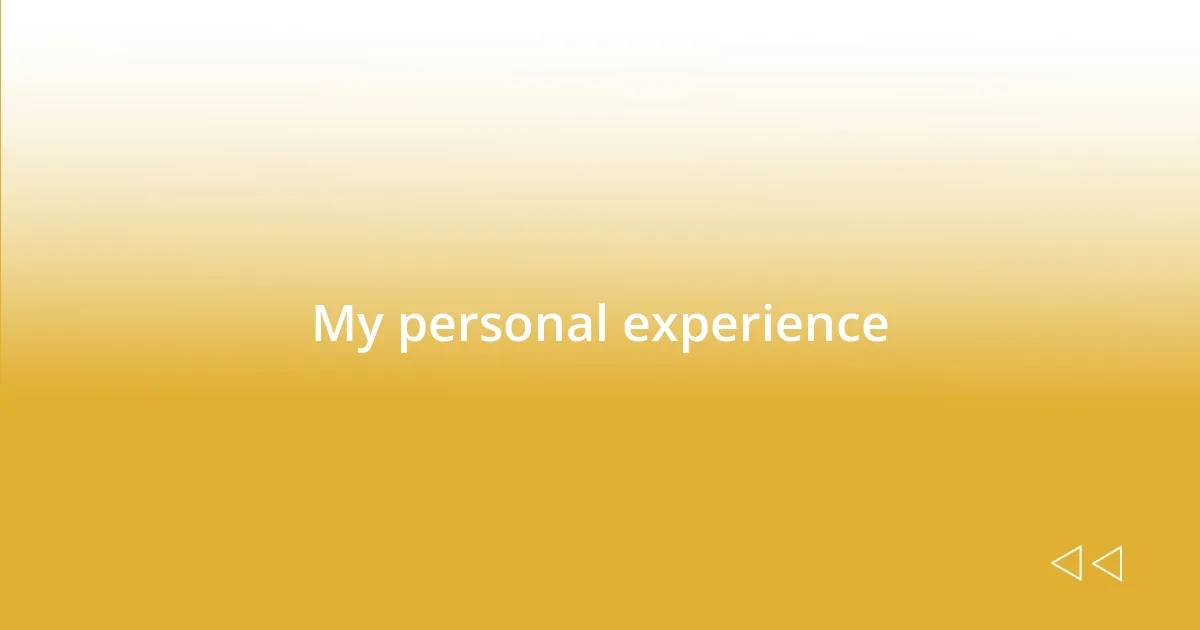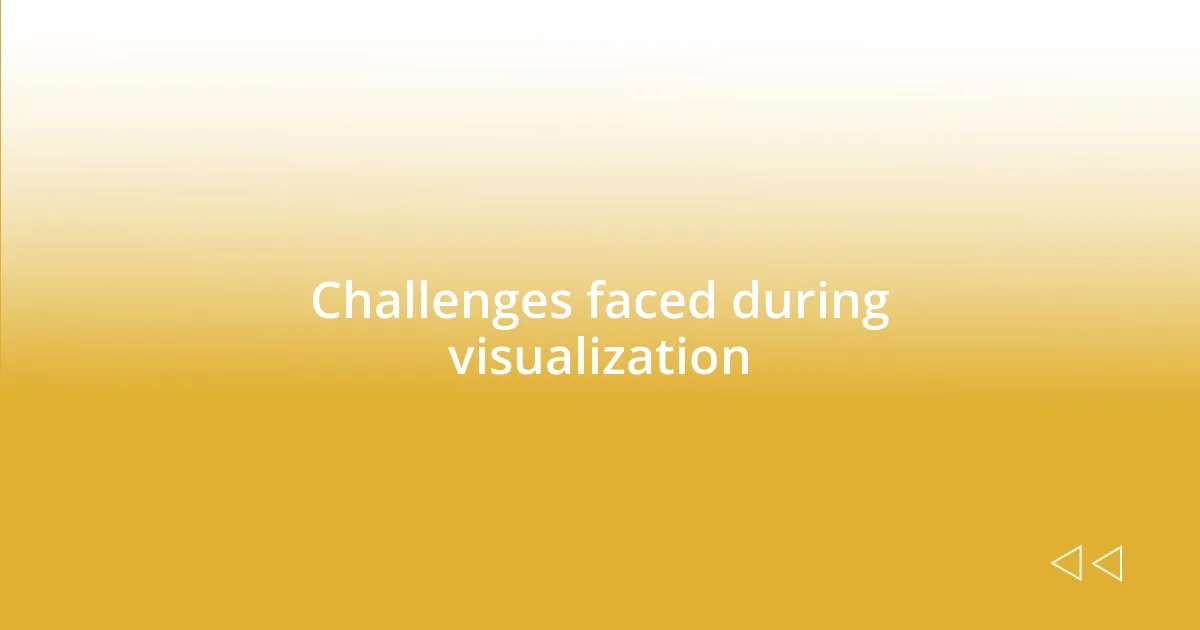Key takeaways:
- Guided visualization enhances relaxation, reduces stress, and boosts self-confidence by engaging all senses and imagining positive outcomes.
- Personal experiences with visualization reveal its emotional healing potential and ability to motivate action towards overcoming challenges.
- Techniques such as using protective imagery and incorporating music can enrich the visualization process, while clear intentions and affirmations enhance effectiveness.
- Challenges include managing intrusive thoughts and skepticism, which can be addressed through patience and deeper emotional exploration.

Understanding guided visualization
Guided visualization is a powerful technique that harnesses the imagination to create vivid mental images. I remember the first time I tried it; I was a bit skeptical but also curious about how simply picturing a calming beach scene could shift my mood. Have you ever found yourself stuck in your thoughts, yearning for a peaceful escape?
What I love about guided visualization is that it’s not just about relaxation; it can serve as a tool for achieving personal goals too. When I visualize my goals, like standing before an audience during a presentation, I can almost feel the butterflies in my stomach, yet there’s also a sense of confidence that comes through the practice. It’s fascinating how our minds can prepare us for real-life experiences before they even unfold.
During my practice, I’ve discovered that engaging all our senses can enhance the experience even more. Imagine hearing the waves crash and feeling the warm sun on your skin—how does that comparison change your understanding of your experiences? This sensory engagement adds a layer of depth to guided visualization, making it an enriching process that offers emotional insights beyond mere recollection.

Benefits of guided visualization
One of the most profound benefits of guided visualization I’ve experienced is its ability to reduce stress and anxiety. There are those days when the weight of my responsibilities feels overwhelming, and I struggle to find my footing. When I close my eyes and envision a serene landscape, like a tranquil forest with sunlight filtering through the leaves, I can feel my body relax. It’s like a mental reset, allowing me to approach challenges with a clearer mind and renewed energy.
Here are some additional benefits I’ve found through guided visualization:
- Enhanced creativity: Engaging my imagination fosters new ideas and perspectives.
- Improved focus: Visualizing specific tasks or goals sharpens my concentration and commitment.
- Increased self-confidence: Imagining successful outcomes boosts my belief in my abilities.
- Emotional healing: Tapping into past experiences through visualization helps me process emotions and release negativity.
In my experience, these benefits not only uplift my mood but also empower me to take actionable steps toward my goals. Metaphorically, it feels as if I’m giving my mind a warm hug, allowing me to step into my best self.

My personal experience
My personal journey with guided visualization has been both enlightening and transformative. The first time I tried it, I found myself transported back to a childhood memory—splashing in the ocean on sun-drenched summer days. I could almost hear the distant laughter of friends, which made me feel joy and a sense of belonging. This vivid experience not only relaxed me but also reminded me of the simple pleasures in life.
As I continued practicing, I often envisioned overcoming challenges. One memorable session had me visualizing myself tackling a difficult personal project. I pictured the steps I needed to take, seeing myself celebrating the small victories along the way. This exercise instilled a powerful sense of motivation within me. Have you ever felt an adrenaline rush just from imagining success? It made me realize how visualization can bridge the gap between dreams and reality.
Interestingly, I’ve also noticed patterns in my emotional responses during visualization. At one point, while revisiting a stressful moment in my life, I focused on visualizing healing and comfort. Surprisingly, tears streamed down my cheeks as I processed those feelings. This emotional release helped me let go of past anxiety, demonstrating how guided visualization can be a caring companion on the journey to self-discovery.
| Experience | Insight |
|---|---|
| First visualization | Joy and belonging through childhood memory |
| Overcoming challenges | Motivation drawn from visualizing success |
| Emotional release | Processing feelings leads to healing |

Techniques I used
When I began using guided visualization techniques, I experimented with a simple method called the “bubble technique.” I would imagine myself inside a protective bubble, shielding me from any negativity or stress. This visualization not only made me feel safe but also allowed negative emotions to flow away from me like leaves carried by a gentle stream. Have you ever imagined yourself in a space of pure tranquility? It was a game-changer for my mental state.
Another technique I found effective was the “step-by-step journey” method. I vividly pictured the process of achieving a goal, breaking it down into manageable steps. For instance, when preparing for a challenging presentation, I saw myself rehearsing confidently and engaging my audience. Each step felt like a mini-celebration, and I could almost hear the applause in my mind. Can you see how this creates a snowball effect of positivity? That visualization transformed my anxiety into excitement.
Finally, I often integrated music into my sessions, creating a unique atmosphere. I’d select calming tunes that matched the serene landscapes I envisioned. While listening to soft melodies, I would visualize a quiet beach at sunset, the sound of waves lapping at the shore, and the warm glow of the setting sun. This multi-sensory experience allowed me to connect even deeper with my visualizations, amplifying the emotions I felt. Have you ever used music to enhance an experience? It truly enriches the journey.

Challenges faced during visualization
One of the biggest hurdles I faced during visualization was dealing with intrusive thoughts. Imagine trying to paint a serene landscape in your mind while a million distractions buzz around you. In my experience, when I found my focus slipping, I had to gently remind myself to return to the mental canvas. This process of refocusing often felt frustrating, but it also taught me the importance of patience and persistence.
Another challenge I encountered was my natural skepticism. At times, I wondered if the visualizations were truly helpful or just my imagination running wild. This internal dialogue often cast shadows over my practice, making me second-guess my progress. Yet, as I continued, I started to notice subtle shifts in my mindset. Those initial doubts slowly gave way to a more open attitude as I recognized the genuine benefits of these guided sessions.
Lastly, I discovered that emotional barriers sometimes surfaced unexpectedly during visualization. There were moments when I’d picture a desired outcome, only to feel a wave of resistance wash over me—almost like fear whispering doubts into my ear. Those experiences were uncomfortable, but they also revealed deeper aspects of myself that needed addressing. Have you ever faced a similar internal conflict? It prompted me to delve into those feelings and ultimately embrace the healing that came from gaining clarity and understanding.

Tips for effective visualization
To make guided visualization effective, I’ve learned that creating a comfortable space is essential. I often choose a quiet room where I won’t be interrupted. Do you notice how the environment can impact your focus? A calming backdrop, perhaps with dim lighting and soft pillows, makes a world of difference—it invites relaxation and sets the mood for deeper visualization.
Another tip that greatly enhanced my practice was to use clear intentions. Before I began each session, I would ask myself what I truly wanted to achieve. It could range from feeling more confident in social situations to envisioning success in my career. Have you ever pinpointed a specific outcome before visualizing? This clarity helps your mind direct its energy where it matters most, leading to more vivid and meaningful images.
Additionally, I found it helpful to incorporate affirmations. During my visualizations, I would repeat positive statements that resonated with my goals. For example, if I was visualizing a successful job interview, I would affirm, “I am confident and capable.” This combination of visualization and affirmations reinforces your beliefs and cultivates a powerful mindset. It’s always fascinating how words can shape our thoughts, don’t you think?

Results and insights gained
The results of my guided visualization practice were genuinely transformative. As I continued through my sessions, I noticed a marked change in how I approached challenges. I began to feel more resilient, and tasks that once seemed daunting now appeared manageable. Has there ever been a moment when you realized you were capable of more than you thought?
Another key insight I gained was the power of visualization in enhancing emotional well-being. After immersing myself in vivid imagery, I often emerged feeling lighter and more centered. I vividly recall one particular session where I envisioned my ideal self—confident and at peace. That lasting sense of tranquility stayed with me throughout the day, influencing my interactions and decisions.
Finally, I uncovered the incredible potential of visualization to sharpen focus and clarity. Before each session, I formulated specific questions I wanted answered or areas of my life I wanted to reflect upon. This practice not only guided my visualization but also provided me with profound realizations that I hadn’t consciously considered. Have you ever asked yourself what you genuinely want, only to be surprised by the answers? It’s remarkable how diving into our subconscious can reveal hidden truths.












